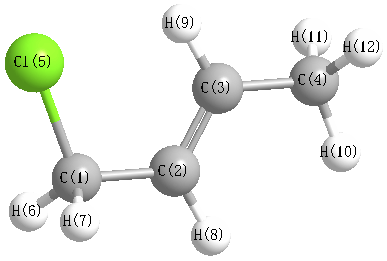Experimental Barriers to Internal Rotation
for CH2ClCHCHCH3 (2-Butene, 1-chloro-)
2015 10 30 09 35
Data from:
1993Dur/Cos:257
Durig, Costner, Wang, Frierson, and Durig. Raman and infrared spectra, conformational stability, barriers to internal rotation, vibrational assignment and ab initio calculations of trans-1-chloro-2-butene. J. Mol. Struct. Vol. 300. pgs. 25y-279.
V1=-371, V2=-103, V3=622, V4=123, V6=-20 cm-1
| torsion index |
Angle |
Energy (kJ mol-1) |
Energy (cm-1) |
| 1 |
0 |
3.20 |
268 |
| 1 |
15 |
4.38 |
366 |
| 1 |
30 |
7.18 |
600 |
| 1 |
45 |
9.64 |
806 |
| 1 |
53 |
10.06 |
841 |
| 1 |
60 |
9.71 |
812 |
| 1 |
75 |
7.01 |
586 |
| 1 |
90 |
3.23 |
270 |
| 1 |
105 |
0.60 |
50 |
| 1 |
116.4 |
0.00 |
0 |
| 1 |
120 |
0.05 |
5 |
| 1 |
135 |
1.24 |
104 |
| 1 |
150 |
3.34 |
279 |
| 1 |
165 |
5.36 |
448 |
| 1 |
180 |
6.21 |
519 |
| 1 |
195 |
5.36 |
448 |
| 1 |
210 |
3.34 |
279 |
| 1 |
225 |
1.24 |
104 |
| 1 |
240 |
0.05 |
5 |
| 1 |
243.6 |
0.00 |
0 |
| 1 |
255 |
0.60 |
50 |
| 1 |
270 |
3.23 |
270 |
| 1 |
285 |
7.01 |
586 |
| 1 |
300 |
9.71 |
812 |
| 1 |
307 |
10.06 |
841 |
| 1 |
315 |
9.64 |
806 |
| 1 |
330 |
7.18 |
600 |
| 1 |
345 |
4.38 |
366 |
| 1 |
360 |
3.20 |
268 |
Atoms in torsion 1 are 7, 5, 10, 11
The rotor type is CH2Cl

Got a better number? Please email us at
[email protected]
